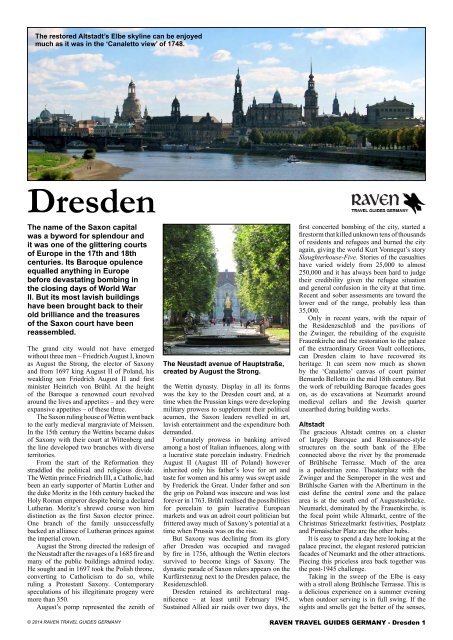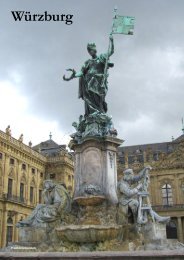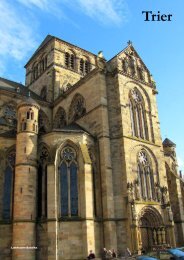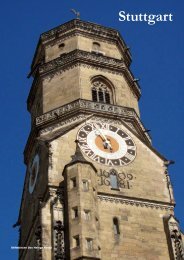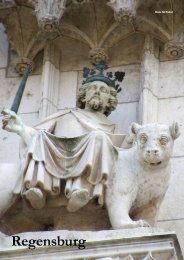Ravens Guide: Germany - Dresden
Create successful ePaper yourself
Turn your PDF publications into a flip-book with our unique Google optimized e-Paper software.
The restored Altstadt’s Elbe skyline can be enjoyed<br />
much as it was in the ‘Canaletto view’ of 1748.<br />
<strong>Dresden</strong><br />
The name of the Saxon capital<br />
was a byword for splendour and<br />
it was one of the glittering courts<br />
of Europe in the 17th and 18th<br />
centuries. Its Baroque opulence<br />
equalled anything in Europe<br />
before devastating bombing in<br />
the closing days of World War<br />
II. But its most lavish buildings<br />
have been brought back to their<br />
old brilliance and the treasures<br />
of the Saxon court have been<br />
reassembled.<br />
The grand city would not have emerged<br />
without three men – Friedrich August I, known<br />
as August the Strong, the elector of Saxony<br />
and from 1697 king August II of Poland, his<br />
weakling son Friedrich August II and first<br />
minister Heinrich von Brühl. At the height<br />
of the Baroque a renowned court revolved<br />
around the lives and appetites – and they were<br />
expansive appetites – of these three.<br />
The Saxon ruling house of Wettin went back<br />
to the early medieval margraviate of Meissen.<br />
In the 15th century the Wettins became dukes<br />
of Saxony with their court at Wittenberg and<br />
the line developed two branches with diverse<br />
territories.<br />
From the start of the Reformation they<br />
straddled the political and religious divide.<br />
The Wettin prince Friedrich III, a Catholic, had<br />
been an early supporter of Martin Luther and<br />
the duke Moritz in the 16th century backed the<br />
Holy Roman emperor despite being a declared<br />
Lutheran. Moritz’s shrewd course won him<br />
distinction as the first Saxon elector prince.<br />
One branch of the family unsuccessfully<br />
backed an alliance of Lutheran princes against<br />
the imperial crown.<br />
August the Strong directed the redesign of<br />
the Neustadt after the ravages of a 1685 fire and<br />
many of the public buildings admired today.<br />
He sought and in 1697 took the Polish throne,<br />
converting to Catholicism to do so, while<br />
ruling a Protestant Saxony. Contemporary<br />
speculations of his illegitimate progeny were<br />
more than 350.<br />
August’s pomp represented the zenith of<br />
The Neustadt avenue of Hauptstraße,<br />
created by August the Strong.<br />
the Wettin dynasty. Display in all its forms<br />
was the key to the <strong>Dresden</strong> court and, at a<br />
time when the Prussian kings were developing<br />
military prowess to supplement their political<br />
acumen, the Saxon leaders revelled in art,<br />
lavish entertainment and the expenditure both<br />
demanded.<br />
Fortunately prowess in banking arrived<br />
among a host of Italian influences, along with<br />
a lucrative state porcelain industry. Friedrich<br />
August II (August III of Poland) however<br />
inherited only his father’s love for art and<br />
taste for women and his army was swept aside<br />
by Frederick the Great. Under father and son<br />
the grip on Poland was insecure and was lost<br />
forever in 1763. Brühl realised the possibilities<br />
for porcelain to gain lucrative European<br />
markets and was an adroit court politician but<br />
frittered away much of Saxony’s potential at a<br />
time when Prussia was on the rise.<br />
But Saxony was declining from its glory<br />
after <strong>Dresden</strong> was occupied and ravaged<br />
by fire in 1756, although the Wettin electors<br />
survived to become kings of Saxony. The<br />
dynastic parade of Saxon rulers appears on the<br />
Kurfürstenzug next to the <strong>Dresden</strong> palace, the<br />
Residenzschloß.<br />
<strong>Dresden</strong> retained its architectural magnificence<br />
– at least until February 1945.<br />
Sustained Allied air raids over two days, the<br />
first concerted bombing of the city, started a<br />
firestorm that killed unknown tens of thousands<br />
of residents and refugees and burned the city<br />
again, giving the world Kurt Vonnegut’s story<br />
Slaughterhouse-Five. Stories of the casualties<br />
have varied widely from 25,000 to almost<br />
250,000 and it has always been hard to judge<br />
their credibility given the refugee situation<br />
and general confusion in the city at that time.<br />
Recent and sober assessments are toward the<br />
lower end of the range, probably less than<br />
35,000.<br />
Only in recent years, with the repair of<br />
the Residenzschloß and the pavilions of<br />
the Zwinger, the rebuilding of the exquisite<br />
Frauenkirche and the restoration to the palace<br />
of the extraordinary Green Vault collections,<br />
can <strong>Dresden</strong> claim to have recovered its<br />
heritage. It can seem now much as shown<br />
by the ‘Canaletto’ canvas of court painter<br />
Bernardo Bellotto in the mid 18th century. But<br />
the work of rebuilding Baroque facades goes<br />
on, as do excavations at Neumarkt around<br />
medieval cellars and the Jewish quarter<br />
unearthed during building works.<br />
Altstadt<br />
The gracious Altstadt centres on a cluster<br />
of largely Baroque and Renaissance-style<br />
structures on the south bank of the Elbe<br />
connected above the river by the promenade<br />
of Brühlsche Terrasse. Much of the area<br />
is a pedestrian zone. Theaterplatz with the<br />
Zwinger and the Semperoper in the west and<br />
Brühlsche Garten with the Albertinum in the<br />
east define the central zone and the palace<br />
area is at the south end of Augustusbrücke.<br />
Neumarkt, dominated by the Frauenkirche, is<br />
the focal point while Altmarkt, centre of the<br />
Christmas Striezelmarkt festivities, Postplatz<br />
and Pirnaischer Platz are the other hubs.<br />
It is easy to spend a day here looking at the<br />
palace precinct, the elegant restored patrician<br />
facades of Neumarkt and the other attractions.<br />
Piecing this priceless area back together was<br />
the post-1945 challenge.<br />
Taking in the sweep of the Elbe is easy<br />
with a stroll along Brühlsche Terrasse. This is<br />
a delicious experience on a summer evening<br />
when outdoor serving is in full swing. If the<br />
sights and smells get the better of the senses,<br />
© 2014 RAVEN TRAVEL GUIDES GERMANY<br />
RAVEN TRAVEL GUIDES GERMANY - <strong>Dresden</strong> 1


